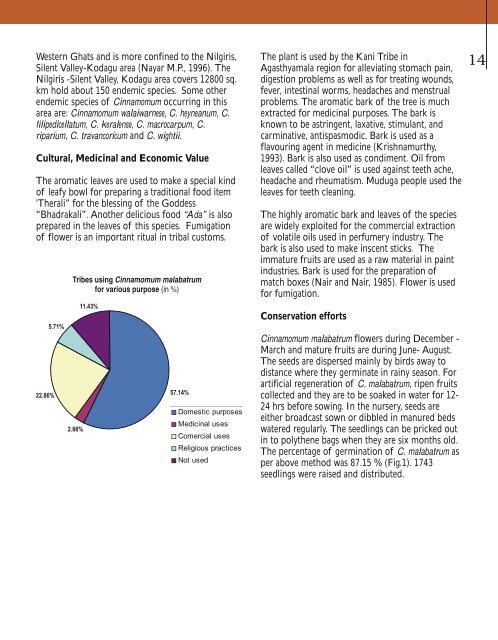Images - IUCN
Images - IUCN
Images - IUCN
Create successful ePaper yourself
Turn your PDF publications into a flip-book with our unique Google optimized e-Paper software.
Western Ghats and is more confined to the Nilgiris,<br />
Silent Valley-Kodagu area (Nayar M.P., 1996). The<br />
Nilgiris -Silent Valley, Kodagu area covers 12800 sq.<br />
km hold about 150 endemic species. Some other<br />
endemic species of Cinnamomum occurring in this<br />
area are: Cinnamomum walaiwarnese, C. heyneanum, C.<br />
filipedicellatum, C. keralense, C. macrocarpum, C.<br />
riparium, C. travancoricum and C. wightii.<br />
Cultural, Medicinal and Economic Value<br />
The aromatic leaves are used to make a special kind<br />
of leafy bowl for preparing a traditional food item<br />
'Therali” for the blessing of the Goddess<br />
“Bhadrakali”. Another delicious food “Ada” is also<br />
prepared in the leaves of this species. Fumigation<br />
of flower is an important ritual in tribal customs.<br />
Number of individuals using Cinnamomum<br />
malabathrum for various purposes<br />
8<br />
2<br />
Tribes using Cinnamomum malabatrum<br />
for various purpose (in %)<br />
1<br />
4<br />
Number of individuals using Cinnamomum<br />
malabathrum for various purposes<br />
8<br />
2<br />
1<br />
4<br />
20<br />
20<br />
Domestic purposes<br />
Medicinal uses<br />
Comercial uses<br />
Religious practices<br />
Not used<br />
The plant is used by the Kani Tribe in<br />
Agasthyamala region for alleviating stomach pain,<br />
digestion problems as well as for treating wounds,<br />
fever, intestinal worms, headaches and menstrual<br />
problems. The aromatic bark of the tree is much<br />
extracted for medicinal purposes. The bark is<br />
known to be astringent, laxative, stimulant, and<br />
carminative, antispasmodic. Bark is used as a<br />
flavouring agent in medicine (Krishnamurthy,<br />
1993). Bark is also used as condiment. Oil from<br />
leaves called “clove oil” is used against teeth ache,<br />
headache and rheumatism. Muduga people used the<br />
leaves for teeth cleaning.<br />
The highly aromatic bark and leaves of the species<br />
are widely exploited for the commercial extraction<br />
of volatile oils used in perfumery industry. The<br />
bark is also used to make inscent sticks. The<br />
immature fruits are used as a raw material in paint<br />
industries. Bark is used for the preparation of<br />
match boxes (Nair and Nair, 1985). Flower is used<br />
for fumigation.<br />
Conservation efforts<br />
Domestic purposes<br />
Cinnamomum malabatrum flowers during December -<br />
March Medicinal and mature uses fruits are during June- August.<br />
The seeds are dispersed mainly by birds away to<br />
distance Comercial where they uses germinate in rainy season. For<br />
artificial regeneration of C. malabatrum, ripen fruits<br />
collected Religious and they practices are to be soaked in water for 12-<br />
24 hrs Not before used sowing. In the nursery, seeds are<br />
either broadcast sown or dibbled in manured beds<br />
watered regularly. The seedlings can be pricked out<br />
in to polythene bags when they are six months old.<br />
The percentage of germination of C. malabatrum as<br />
per above method was 87.15 % (Fig.1). 1743<br />
seedlings were raised and distributed.<br />
14

















